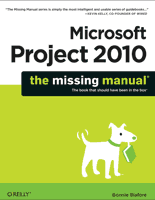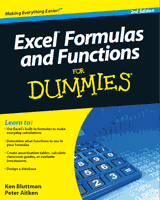| Using Microsoft® Excel® 2010 | Tracy Syrstad and Bill Jelen | Pearson Education, Inc. | 2011 | English | 323 p | pdf | 8.32 MB | ISBN-13: 978-0-7897-4290-2 | This book allows you to customize your own learning experience. The step-by-step instructions in the book give you a solid foundation in using Excel 2010, and rich and varied online content, including video tutorials and audio sidebars. Excel is an amazingly flexible program. A new Excel worksheet offers a seemingly endless blank canvas of rows and columns where you can enter, summarize, and report data of any type. Charts and other data visualization tools can convert a page full of numbers to a visual snapshot. Pivot tables can summarize thousands of detailed records to a one-page summary in a few mouse clicks. If you’ve never opened Excel, or if you’ve used Excel only to neatly arrange lists in columns, this book will get you up to speed with the real-life skills needed to survive in a job that requires familiarity with Excel. |
Free download ebook - Using Microsoft® Excel® 2010. Familiarity with Microsoft Excel is a requirement for most jobs today. Workers in every office use Excel to track and report information. Sales reps track leads, prospects, commissions, and travel expenses in Excel. Workers on the factory floor log schedules and quality data in Excel.
Excel is an amazingly flexible program. A new Excel worksheet offers a seemingly endless blank canvas of rows and columns where you can enter, summarize, and report data of any type. Charts and other data visualization tools can convert a page full of numbers to a visual snapshot. Pivot tables can summarize thousands of detailed records to a one-page summary in a few mouse clicks.
If you’ve never opened Excel, or if you’ve used Excel only to neatly arrange lists in columns, this book will get you up to speed with the real-life skills needed to survive in a job that requires familiarity with Excel.
Excel Comes in Many Flavors
When a potential employer asks if you know Excel, you need to ask which version of Excel. There are a lot of products available that have Excel in the name, but offer a different subset of commands.
This book discusses more than 150 of these functions. But rather than just show their syntax and list them alphabetically, we have assembled them by category and provided real examples of how to use them alone, and in formulas, along with step-by-step instructions and illustrations of the results.
If this is your first experience with Excel, going to work in an office that is still using Excel 2003 is going to present some frustrations for you and the employer as you try to adjust to the older version of Excel. If the company is still using Excel 2003, it either means that they didn’t have the money to upgrade or that the people at the company are firmly entrenched with and know the old Excel very well. Be up front with your manager. Explain that you learned Excel using Excel 2010. That manager resisted upgrading to Excel 2010 because he or she didn’t want to take the time to get up the learning curve to learn the new Ribbon interface. As someone who learned on Excel 2010, it will be just as intimidating to learn where familiar commands are in the old Excel environment.
This book allows you to customize your own learning experience. The step-by-step instructions in the book give you a solid foundation in using Excel 2010, and rich and varied online content, including video tutorials and audio sidebars.
How This Book Is Organized
This book teaches you the important functions and uses for Microsoft Excel. You should be able to turn to any page and learn a task that will help you in your job using Excel.
Additional content, such as video tutorials, demonstrate key concepts.
The concepts in this book will allow you to get started by entering data and formulas in Excel. However, the later chapters on pivot tables and charting will provide you with enough advanced techniques to allow you to thrive in any job requiring Excel.
After you get up to speed with entering data and formulas in Excel, you might have a tendency to leave this book on the shelf. As your experience with Excel grows, you should come back to peruse the later chapters. Remember that there are usually five ways to accomplish every task in Excel. While you could successfully add subtotals to a data set using the formula skills from Chapter 5, “Using Formulas,” there is a good chance that using the Subtotal function from Chapter 9, “Subtotals and Grouping,” will allow you to accomplish the same task in a fraction of the time. Although you might not realize that you have a need for pivot tables at this moment, as you begin doing more tasks in Excel, it is likely that you will discover that Chapter 10, “Pivot Tables,” can dramatically simplify an otherwise tedious task. By revisiting this book once every few weeks, you may discover faster ways to solve real tasks that you encounter at work.
Using This Book
This book allows you to customize your own learning experience. The step-by-step instructions give you a solid foundation in using Excel 2010, and rich and varied online content, including video tutorials and audio sidebars, provide the following :
- Demonstrations of step-by-step tasks covered in the book;
- Additional tips or information on a topic;
- Practical advice and suggestions;
- Direction for more advanced tasks not covered in the book.
Special Features
More than just a book, your USING product integrates step-by-step video tutorials and valuable audio sidebars delivered through the free web edition that comes with every USING book. For the price of the book, you get online access anywhere with a web connection—no books to carry, content is updated as the technology changes, and you benefit from video and audio learning.
 Free Download - Microsoft Project 2010 ebook Series, Is a collection of eBooks Microsoft Project 2010. Consists of four books (in english) plus one book (in indonesian), including: Microsoft Project 2010: The Missing Manual; Microsoft Project 2010 : Step by Step; Microsoft Project 2010 Bible; and Microsoft Project 2010 Project Management: Real World Skills for Certification and Beyond; plus Microsoft Project 2010 : Pendekatan Siklus Proyek, Langkah Cerdas Merencanakan dan Mengelola Proyek. All of which you can download for free.
Free Download - Microsoft Project 2010 ebook Series, Is a collection of eBooks Microsoft Project 2010. Consists of four books (in english) plus one book (in indonesian), including: Microsoft Project 2010: The Missing Manual; Microsoft Project 2010 : Step by Step; Microsoft Project 2010 Bible; and Microsoft Project 2010 Project Management: Real World Skills for Certification and Beyond; plus Microsoft Project 2010 : Pendekatan Siklus Proyek, Langkah Cerdas Merencanakan dan Mengelola Proyek. All of which you can download for free.























